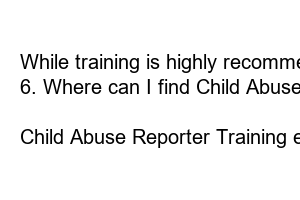아동학대 신고의무자 교육
Title: Child Abuse Reporter Training: Empowering Guardians to Safeguard Children
Introduction:
Child abuse is a grim reality that continues to haunt countless innocent lives around the world. As responsible members of society, it is our duty to protect and advocate for the well-being of vulnerable children. This blog post explores the significance of Child Abuse Reporter Training and how it equips individuals with the vital knowledge and skills necessary to intervene effectively in suspected cases of child abuse.
1. Understanding the Importance of Child Abuse Reporter Training:
Child Abuse Reporter Training plays a pivotal role in creating a safe and secure environment for children. By educating adults on identifying signs of abuse, understanding laws and policies, and implementing appropriate reporting protocols, we can contribute to the prevention and early intervention of child abuse situations.
2. Key Elements Taught in Child Abuse Reporter Training:
Participants in this training will receive comprehensive guidance on how to recognize different types of abuse, including physical, emotional, sexual, and neglect. Learners will also understand the psychological impacts of abuse, the role of trauma-informed care, and the legal responsibilities associated with reporting suspicions of child abuse.
3. Learning Effective Communication Techniques:
One essential aspect of Child Abuse Reporter Training is honing communication skills. Participants will gain insights into *active listening*, empathetic responses, and effective questioning techniques. These tools enable them to engage with children and obtain crucial information while ensuring their safety and emotional well-being.
4. Implementing Proper Reporting Procedures:
Child Abuse Reporter Training equips attendees with the knowledge of legal requirements and reporting guidelines. They will learn how and when to report suspected child abuse to the relevant authorities, ensuring prompt and appropriate interventions to protect the child at risk.
5. Building Collaborative Partnerships:
Recognizing that addressing child abuse requires a multidisciplinary approach, this training fosters collaboration among various professionals, such as educators, healthcare providers, and social workers. By promoting coordination and sharing information, these partnerships strengthen the overall response to child abuse and enhance child protection efforts.
6. The Need for Continuing Education:
Given the ever-evolving nature of child abuse issues, keeping abreast of current trends, research, and best practices is crucial. Child Abuse Reporter Training provides ongoing opportunities for professionals to expand their knowledge, refine their skills, and stay updated on child protection procedures.
FAQs:
1. What is the duration of Child Abuse Reporter Training?
Child Abuse Reporter Training programs vary in length, ranging from a few hours to several days. The duration typically depends on the depth and breadth of the curriculum and the target audience.
2. Are there any prerequisites to participate in the training?
No specific prerequisites are necessary for attending Child Abuse Reporter Training. It is open to anyone seeking to become an advocate for child protection.
3. Can online training be pursued?
Yes, numerous organizations offer online Child Abuse Reporter Training. These virtual programs cater to individuals from various professions and are flexible to accommodate busy schedules.
4. Will completing this training make me a mandated reporter?
Each country or state may have different laws and policies defining mandated reporters. While Child Abuse Reporter Training may be required for certain professions, completing the training alone does not automatically confer mandated reporter status. It is essential to refer to local regulations to determine reporting obligations.
5. Can I take action against child abuse without training?
While training is highly recommended to effectively identify and report child abuse, anyone can take action if they suspect a child is being abused. Reporting concerns to the appropriate agency or hotline can initiate an investigation, leading to the necessary support and interventions for the child.
6. Where can I find Child Abuse Reporter Training programs?
Child Abuse Reporter Training programs are offered by numerous organizations, including child advocacy centers, social service agencies, and online training platforms. Local law enforcement agencies and child welfare organizations often provide information on available training opportunities.
Summary:
Child Abuse Reporter Training empowers individuals with the knowledge and skills required to protect children by recognizing and reporting suspected abuse. By comprehensively teaching the signs of abuse, fostering effective communication, guiding proper reporting procedures, and promoting collaboration, this training plays a vital role in safeguarding and advocating for the well-being of vulnerable children. Take a step towards making a difference in a child’s life by participating in Child Abuse Reporter Training today.

